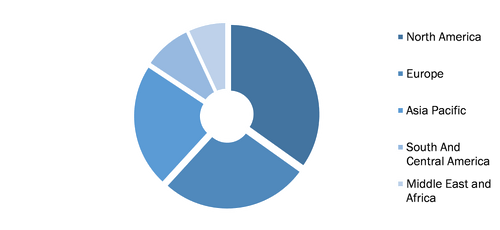Speech Recognition Segment to Account for Maximum Share in Healthcare Virtual Assistants Market During 2021–2028
According to our latest study on “Healthcare Virtual Assistants Market Forecast to 2028 – COVID-19 Impact and Global Analysis – by Component and End-User the market is projected to reach US$ 5,310.31 million by 2028 from US$ 684.07 million in 2021; it is expected to grow at a CAGR of 34.01% from 2021 to 2028. The report highlights the key factors driving the market growth and prominent players with their developments in the market.
Based on component, the healthcare virtual assistants market is segmented into speech recognition, text-to-speech, and voice recognition. The speech recognition segment is likely to account for the largest market share during 2021–2028.
By end user, the healthcare virtual assistants market is segmented into providers, payers, and others. The providers segment held a considerable market share in 2021 and is likely to continue its dominance during the forecast period. According to the American Telemedicine Association (ATA) report, healthcare virtual assistants possesses numerous advantages for patients and providers. For instance, on the removal of physical barriers to care, providers can extend their reach with the help of virtual assistants, particularly for patients living in rural areas.Also, they can offer preventive services allowing the patient education or wellness coaching regarding nonemergency health and wellness issues. The expansion of the market can assist providers in monitoring and managing their patients' care throughout their recovery following a long-term hospital visit or surgical procedure. The market expansion can also act as a substitute for in-person care delivery based on patient population needs, health organization capabilities, and resource availability, which will ultimately help providers to increase efficiency by seeing more patients with a greater degree of personal engagement in less time, thereby contributing to easing workloads resulting in reducing stress. The factors mentioned above support the market growth for the providers segment.
The COVID-19 pandemic has significantly triggered the adoption of healthcare virtual assistants and will continue a similar trend in the coming years. The utility of interactive two-way video teleconferencing in medical consultation mitigates the volume of nonessential in-person visits at hospitals, preserving critical resources and supplies required for treating COVID-19 patients. Digital tools also gained significant attention in the fight against COVID-19. For instance, the Arxiv report states that, intelligent conversational agents and virtual assistants have proven effective and possess the potential to serve as an intermediary for reducing the burden on the healthcare system intended for monitoring and consulting patients through versatility, accessibility, and scalability for naturalistic communication. For records, chatbots and voice assistants (VA) are famous examples of intelligent conversational agents and virtual assistants amid COVID-19 pandemic.
Nuance Communications, Inc.; Amazon.com, Inc.; Verient Systems, Inc.; Microsoft Corporation; EGAIN CORPORATION; Infermedica; CSS Corp; Kognito; Babylon; and True Image Interactive Inc. are among the leading companies operating in the healthcare virtual assistants market.
Healthcare Virtual Assistants Market, by Region, 2021 (%)

Healthcare Virtual Assistants Market Share and Growth - 2028
Download Free Sample
Healthcare Virtual Assistants Market Forecast to 2028 - COVID-19 Impact and Global Analysis By Component (Speech Recognition, Text-to-Speech, and Voice Recognition) and End User (Providers, Payers, and Others)
Healthcare Virtual Assistants Market Share and Growth - 2028
Download Free SampleHealthcare Virtual Assistants Market Forecast to 2028 - COVID-19 Impact and Global Analysis By Component (Speech Recognition, Text-to-Speech, and Voice Recognition) and End User (Providers, Payers, and Others)
Contact Us
Phone: +1-646-491-9876
Email Id: sales@theinsightpartners.com